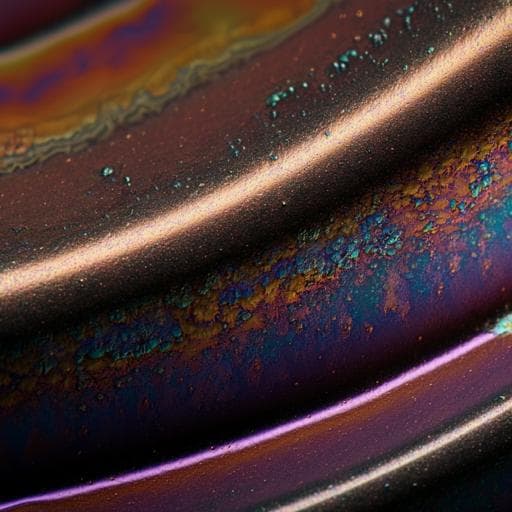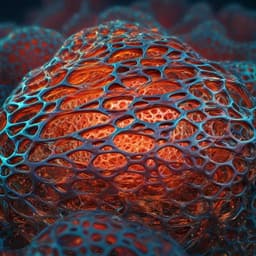
Engineering and Technology
Highly reversible zinc metal anode enabled by strong Brønsted acid and hydrophobic interfacial chemistry
Q. Nian, X. Luo, et al.
Discover a groundbreaking approach to enhancing zinc anode reversibility in batteries! Researchers, including Qingshun Nian and Xuan Luo, unveil how bis(trifluoromethanesulfonyl)imide transforms battery interfacial chemistry, achieving impressive performance metrics like a Coulombic efficiency of 99.7%. This work could redefine the future of energy storage.
~3 min • Beginner • English
Introduction
Aqueous rechargeable zinc batteries (RAZBs) are attractive for grid-scale energy storage due to safety, low cost, and the favorable properties of Zn metal (abundance, 820 mAh g⁻¹ capacity, low redox potential). However, Zn metal undergoes parasitic reactions with water, including self-corrosion and hydrogen evolution, generating OH⁻ and precipitating insulating alkaline byproducts such as Zn₄SO₄(OH)ₓ·H₂O (ZSH), Zn(OH)₂, and ZnO on the anode surface. These processes reduce Coulombic efficiency, promote dendrite growth, and persist during both cycling and idle periods, creating a self-sustaining loop: OH⁻ produced at the anode migrates to the cathode, disturbs electrolyte pH, and induces byproduct accumulation at the cathode, degrading capacity. Conventional strategies minimize H₂O reactivity via concentrated or structured electrolytes, but do not remove alkaline deposits that build up during rest and cycling. To break this cycle and enable uniform Zn deposition, the authors propose introducing acidic species to consume OH⁻ and prevent byproduct precipitation. Although acids can also corrode Zn via Zn + 2H⁺ → Zn²⁺ + H₂, careful selection and concentration control may mitigate corrosion while leveraging acid to clean the surface. The study explores using a strong Brønsted acid, HTFSI, whose hydrophobic TFSI⁻ anion can enrich at the Zn interface, reduce H₂O contact, and induce a protective ZnS-rich interphase, thereby suppressing self-corrosion, HER, and nonuniform deposition.
Literature Review
Electrolyte engineering has focused on suppressing water activity or altering Zn²⁺ solvation to mitigate corrosion and HER: high-concentration Zn(TFSI)₂ with LiTFSI achieved CE ~99.7% by reducing free H₂O; localized high-concentration aqueous electrolytes (LHCE) with non-solvating diluents (e.g., 1,4-dioxane) improved rate capability and cost, promoting fluorinated interphases (e.g., ZnF₂). Various organic co-solvents (DMSO, ethylene glycol, EGME, tetraglyme) partially replace H₂O in solvation, improving CE but introducing flammability concerns. Chloride-based electrolytes (e.g., ZnCl₂ with LiCl, or with additional chlorides and dimethyl carbonate) also enhanced plating/stripping and mitigated HER. Despite these advances, strategies generally reduce water reactivity but do not directly address alkaline byproduct accumulation (e.g., ZSH) formed during rest and cycling, which leads to heterogeneous deposition and continuous degradation. The present work proposes acidic additives to scavenge OH⁻ and prevent byproduct precipitation, while leveraging interfacial hydrophobicity to suppress corrosion.
Methodology
Materials: ZnSO₄·7H₂O, HTFSI (bis(trifluoromethanesulfonyl)imide), V₂O₅, Zn(CH₃COO)₂·2H₂O, H₂O₂, H₂SO₄, Super C65 carbon, PTFE, glass microfiber filters, Zn foils (10 µm, 50 µm), Cu foil, Ti mesh.
Electrolytes: 1 m ZnSO₄ in DI water; HTFSI added at 0.01, 0.02, 0.05, 0.1, 0.2, 0.5, 1.0 m to prepare modified electrolytes. Ion conductivity measured in a micro-cell by EIS and referenced to 1 M KCl; 1 m ZnSO₄ + 0.1 m HTFSI showed higher conductivity due to mobile protons.
ZVO synthesis: 0.50 g V₂O₅ mixed with 7.7 g water and 2.5 g H₂O₂ (stir 15 min), add 40 g water, sonicate 2 h; add 0.15 g Zn(CH₃COO)₂·2H₂O, remix; hydrothermal at 180 °C for 90 min in Teflon vessel; centrifuge, wash (water, ethanol), dry at 60 °C for 24 h to obtain Zn vanadate (ZVO) nanostructures.
Cell assembly: Coin-type 2032 cells assembled in air. Zn||Zn: Zn foils as both electrodes, glass microfiber separator, 100 µL electrolyte (1 m ZnSO₄ or 1 m ZnSO₄ + x m HTFSI). Zn||Cu: Zn (Φ12 mm) and Cu (Φ16 mm) with same separator and electrolyte, 100 µL. Zn||ZVO: cathode of ZVO/Super C65/PTFE (70/20/10 wt%) pressed on Ti mesh (Φ12 mm), mass loading ~2 mg cm⁻²; Zn anode; 100 µL electrolyte. Testing on Neware cyclers at room temperature. Note: 10 µm Zn foil used only for DOD tests.
Electrochemical tests: CE of Zn plating/stripping in Zn||Cu at specified current densities/areal capacities with 0.5 V cutoff; Zn||Zn galvanostatic symmetric cycling and step-rate tests; CV on BioLogic VMP3 at defined scan rates; EIS (0.1 Hz–1 MHz, 10 mV) on Zn||Zn, at 0–30 °C; chronoamperometry; Tafel plots in three-electrode cell with Zn working/counter and Ag/AgCl reference, ±0.25 V at 1 mV s⁻¹; in situ pH monitoring in Zn||Zn using a micro pH electrode; gas chromatography (GC9720plus, TCD) to quantify H₂ evolution using a custom battery module with gas ports.
Characterizations: SEM/EDS (FEI-SEM 7800 F Prime, 5 kV for SEM; 20 kV for EDS mapping), TEM (JEOL 2100F), XRD (Rigaku SmartLab, Cu Kα), GIXRD for surface phases, XPS (Thermo ESCALAB 250XI) with Ar⁺ sputtering (depths 0, −2, −10, −20 nm; C 1s at 284.8 eV for calibration); Raman (Horiba LabRAM HR Evolution, 532 or 633 nm) for electrolyte structure; in situ Raman on perforated coin-cell configuration with ZVO working and Zn counter/reference; SERS using SiO₂-shelled Au nanoparticles on Zn to probe interfacial species; white light interference microscopy for morphology.
Computational: Ab initio MD (CP2K, PM6-D3) with explicit water in NVT at 320 K (Nosé-Hoover chains), 1 fs timestep, 20 ps runs, last 10 ps analyzed; simulation box 26.2×22.7×74.4 Å with vacuum along z; Zn slab of 4 atomic layers; species corresponding to 1 m ZnSO₄ with and without HTFSI; number density profiles of H₂O, SO₄²⁻, and TFSI⁻ computed; visualization and density statistics with VMD.
Comparative acids: Additional tests with H₂SO₄, HCl, H₃PO₄, and HOTf additives; and with alternative Zn salts (ZnCl₂, Zn(CH₃COO)₂) to evaluate generality.
Key Findings
- Strong Brønsted acid HTFSI (0.1 m) in 1 m ZnSO₄ prevents alkaline byproduct (ZSH) accumulation on Zn during rest and cycling, enabling uniform Zn deposition.
- In situ pH during rest: 1 m ZnSO₄ increased from 4.76 to 5.47 in 180 min with large fluctuations (indicative of self-corrosion), while 1 m ZnSO₄ + 0.1 m HTFSI remained acidic, rising slightly from 1.57 to 1.71.
- Surface analyses after soaking: In 1 m ZnSO₄, abundant ZSH formed (confirmed by XRD), with EDS showing significant S and O; with 0.1 m HTFSI, surfaces remained smooth and free of ZSH (SEM/EDS), even under O₂-saturated conditions.
- Zn||Cu CE: At 1 mA cm⁻², 0.5 mAh cm⁻², CE stabilized to 99% within 40 cycles and reached 99.7% over 1400 cycles with HTFSI; baseline failed after ~180 cycles with fluctuating CE. Initial CE improved from 86.48% (ZnSO₄) to 93.27% (with HTFSI).
- High-rate CE: At 4 mA cm⁻², 2 mAh cm⁻², CE exceeded 99% within 10 cycles and sustained up to ~99.85% for 550 cycles with HTFSI.
- Kinetics: HTFSI reduced nucleation and growth overpotentials on Cu; activation energy for Zn deposition decreased to 47.88 kJ mol⁻¹; chronoamperometry showed stable currents indicative of 3D diffusion and suppressed byproduct formation.
- Corrosion metrics: Corrosion potential shifted from −0.99 to −0.97 V vs Ag/AgCl and corrosion current density decreased from 1.62 to 0.64 mA cm⁻² with HTFSI, indicating lower corrosion tendency and rate.
- Hydrogen evolution: GC measurements showed reduced H₂ evolution during cycling with HTFSI despite acidity, attributed to more uniform deposition and modified interphase.
- Symmetric Zn||Zn: With HTFSI, stable polarization ~30.5 mV and ultra-long life of 2200 h at 4 mA cm⁻² and 4 mAh cm⁻²; rate capability stable up to 17 mA cm⁻²; deep discharge: stable cycling for >100 h at 10 mA cm⁻²/10 mAh cm⁻² with 50 µm Zn (DODZn >34%) and for 1000 h at 2 mA cm⁻²/2 mAh cm⁻² with 10 µm Zn (DOD >34%). Lower impedance observed vs baseline.
- Morphology: Deposits in HTFSI electrolyte were dense and uniform with ~4.3 µm thickness vs mossy ~14.8 µm in baseline; EDS showed Zn 73.89%, O 25.31%, S 0.80% (no ZSH enrichment) vs higher and uneven S (4.71%) and O (61.58%) in baseline; XRD confirmed ZSH absence with HTFSI and presence with baseline.
- Full cells (Zn||ZVO): Initial reversible capacity 237 mAh g⁻¹ at ~0.8 V; improved rate capability across 0.5–10 A g⁻¹, retaining 108.5 mAh g⁻¹ at 10 A g⁻¹; self-discharge after 24 h retained 94.98% capacity vs 72.85% baseline; long-term cycling at 2 A g⁻¹ retained 182 mAh g⁻¹ after 2000 cycles (76.8% retention) with near-100% CE.
- Mechanism: SERS showed enrichment of TFSI⁻ at the Zn surface (TFSI/SO₄ peak area ratio increased from 0.194 in bulk to 0.230 at interface); AIMD revealed TFSI⁻ accumulation and decreased H₂O density near Zn, forming an H₂O-deficient, hydrophobic interfacial region.
- SEI chemistry: XPS/GIXRD detected ZnS (with ZnSO₄ + HTFSI) enriched in the inner SEI; formation attributed to superacid-induced reduction of SO₄²⁻ to ZnS. ZnS not detected with ZnCl₂ or Zn acetate systems, consistent with sulfate-derived origin. ZnF₂ considered less favorable due to higher aqueous solubility versus ZnS (Ksp ~3.04×10⁻² vs 2.5×10⁻23 at 25 °C).
- Acid comparisons: H₂SO₄ and other acids (HCl, H₃PO₄, HOTf) improved CE to varying degrees and reduced ZSH formation on Zn, but cycle life and CE were inferior to HTFSI; ZSH could still appear on Cu with H₂SO₄; neither H⁺ nor TFSI⁻ alone yielded comparable performance, indicating synergistic effect.
Discussion
The study addresses the core challenge of Zn anode instability in aqueous electrolytes: self-corrosion generates OH⁻ that precipitates insulating byproducts (ZSH), promoting nonuniform deposition and capacity fade, and this process continues during rest. Introducing the strong Brønsted acid HTFSI directly scavenges OH⁻ at rest and during cycling, preventing byproduct precipitation on both anode and cathode. Simultaneously, the hydrophobic TFSI⁻ anion enriches at the Zn surface, displacing interfacial water and creating an H₂O-deficient microenvironment that suppresses corrosion and HER. The superacidic interfacial region induces the formation of a ZnS-rich SEI from sulfate, which is less soluble than ZnF₂ and thus more effective at isolating Zn from aqueous corrosion. These interfacial effects reduce nucleation/growth barriers, lower activation energy, and homogenize deposition, yielding high Coulombic efficiencies (up to ~99.85% at high rates), long symmetric-cell lifetimes (2200 h at 4 mA cm⁻²/4 mAh cm⁻²), reduced hydrogen evolution, and superior ZVO full-cell rate and cycle performance with low self-discharge. Comparisons with other acids and with single-component additives show that both protons and the hydrophobic TFSI⁻ are required: acids alone mitigate OH⁻ but do not ensure durable interphases or prevent ZSH formation on current collectors, while TFSI⁻ alone is insufficient. The mechanism is general in enhancing Zn reversibility across different Zn salts, though ZnS formation is specific to sulfate systems. Overall, the findings demonstrate a practical and mechanistically grounded route to stabilize Zn metal anodes by modulating interfacial chemistry rather than solely suppressing water activity.
Conclusion
This work demonstrates that a strong, hydrophobic Brønsted acid (HTFSI) added to a conventional 1 m ZnSO₄ electrolyte reformulates interfacial chemistry to enable highly reversible Zn metal anodes. HTFSI both scavenges OH⁻ to prevent alkaline byproduct precipitation and enriches hydrophobic TFSI⁻ at the Zn surface to form an H₂O-deficient interfacial region that induces a ZnS-rich protective SEI. The resulting systems deliver high Zn plating/stripping CE (~99.7% at 1 mA cm⁻², >99.8% at higher rate/capacity), long symmetric-cell lifetimes (2200 h at 4 mA cm⁻²/4 mAh cm⁻²), and robust Zn||ZVO full-cell performance with 76.8% capacity retention after 2000 cycles and low self-discharge. The study overturns the conventional view that acids necessarily degrade Zn anodes and highlights the importance of interfacial hydrophobic superacid chemistry. Future work could optimize acid concentration windows, explore other hydrophobic superacids or anions to broaden compatibility across different Zn salts and cathode chemistries, investigate pouch/prismatic formats and temperature extremes, and deepen mechanistic understanding of sulfate reduction pathways and interphase evolution.
Limitations
- Acid dosage window: Excess HTFSI leads to increased HER and Zn corrosion; performance is sensitive to concentration (0.1 m optimal among tested).
- Salt dependence of SEI chemistry: ZnS formation was observed with sulfate but not with chloride or acetate salts, indicating mechanism specificity; benefits may vary with electrolyte anion.
- Rest condition acidity: Even with HTFSI, pH can rise with prolonged rest (e.g., to 3.58 after 10 h), suggesting finite buffering/consumption over long idle times.
- Cell format and conditions: Results are from coin cells at room temperature; scalability, long-term stability under practical conditions (temperature extremes, lean electrolyte, limited Zn) and safety were not fully evaluated.
- Cathode generality: Full-cell validations focused on ZVO; broader cathode compatibility and high-loading electrodes need assessment.
Related Publications
Explore these studies to deepen your understanding of the subject.







